
The Bustle of Bath or the Quiet Lanes of Chawton?
[caption id="JaneAustenatHome_Feature" align="aligncenter" width="1024"]
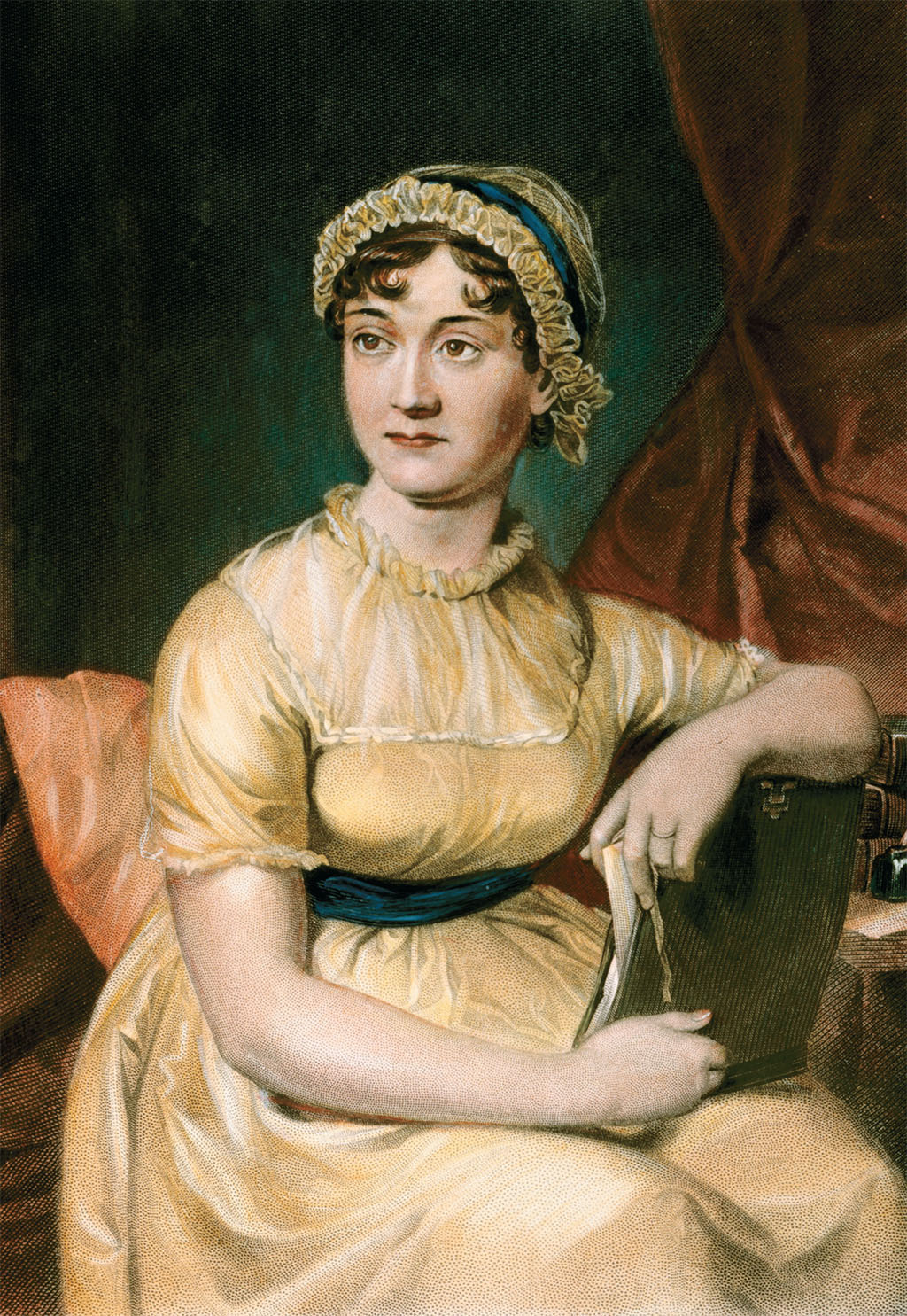
THE GRANGER COLLECTION, NEW YORK
It seems like Goliath calling out a pretty puny David. Bath, and in particular enthusiasts of the city’s annual Jane Austen Festival, created something of a flap this past autumn when they contended the lovely Regency spa city was internationally recognized now as Austen’s “true home.”
Not surprisingly, folks in the tiny Hampshire village of Chawton took some umbrage at that idea. After all, Austen lived in Chawton with her mother and sister (both named Cassandra) from 1809 until her death in 1817. Moreover, it was in Chawton that Austen completed each of the six novels that comprise her published works.
Being an ardent Jane Austen devotee since my salad days, I decided to revisit the principal scenes of her life, and weigh in for British Heritage readers.
Neither Bath nor Chawton, of course, can claim to be Jane Austen’s hometown. If there were such a place, it would be Steventon, a dozen miles from Chawton to the northwest, off the A33 near Basingstoke. Unfortunately, Steventon isn’t much of a village, let alone a town.
It was in Steventon that Austen was born in 1775, the seventh of eight children of the village rector, the Rev. George Austen. She grew up in the bustling rectory and in the social world that we recognize in her novels. Here she began the stories that became Sense and Sensibility, Pride and Prejudice and Northanger Abbey. After a generation as rector in the village parish, George Austen retired in 1804 and the family moved to Bath.
[caption id="JaneAustenatHome_img1" align="aligncenter" width="1024"]
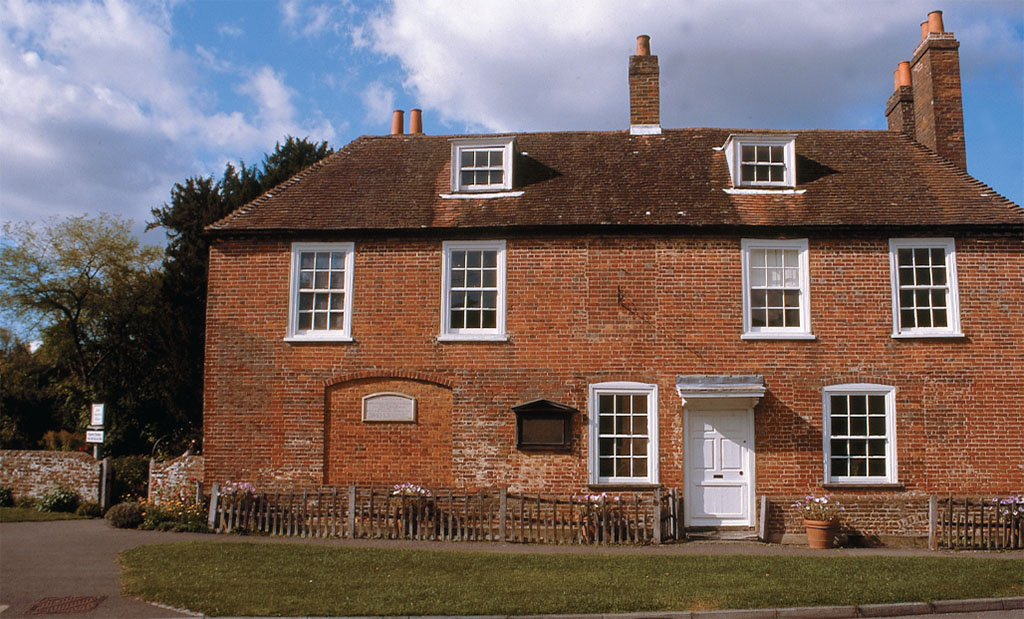
DANA HUNTLEY
Two of Jane Austen’s brothers and a nephew succeeded her father as the rector in Steventon. In 1823, however, Jane’s brother built a new rectory on the hillside opposite, and the home Jane Austen would have known, with its outbuildings, cottages and gardens, was demolished. Tiny St. Nicholas Church, complete with 900-year old yew tree in the churchyard, is the only physical reminder of the Austen presence in the rural hamlet.
Crowded, noisy and “fast,” Bath would have been familiar to Jane, but it certainly would have presented a different way of life from the domestic routines of a quiet Hampshire village. As the center of Regency social life for the gentry and minor nobility, Bath was the ultimate in fashion, activity and social programming.
Established in a beautiful Georgian town house at 4 Sydney Place at the nether end of Great Pulteney Street, the Austens would have been caught up in the social life of Bath—whether they wanted to be or not. As Jane’s novels make clear, the social obligations and expectations of the gentry (which included retired clergymen and their families) were taken seriously and not flouted with impunity.
Bath life was a nonstop round of being “at home” to visitors and returning calls in turn. In between, there were assignations at the Assembly Rooms and the Baths, shopping on Milsom Street and a full schedule of concerts, lectures and, yes, balls to attend. The quiet evenings at home in Steventon and time for creative contemplation and writing would quickly have been a memory.
There is little evidence that Jane Austen did have the time or motivation to work on her novels during those years in Bath. Certainly she portrayed the city and its social life with brilliantine clarity in Northanger Abbey and Persuasion, but that was looking back a few years later.
The Rev. Austen died in 1807 and is buried in Bath at St. Swithin’s churchyard. After a short stay in Southampton, the female Austens moved to Chawton, where Jane’s brother, as lord of the manor, provided them with an eight-room “cottage” in the center of the village. Jane fell in love with the house, and there is every indication that the Austen women were decidedly happy there together. What we do know is that these Chawton years were the most productive of Jane’s unfortunately brief literary career.
In eight years at Chawton, Jane polished the manuscripts of her early novels into finished form and penned Emma, Mansfield Park and Persuasion. Though she certainly shared her writing with her sister, Jane kept her novel writing a closely guarded secret. Her writing desk still stands at Chawton Cottage, capped with a large desk pad under which she could surreptitiously slide her manuscript if anyone came into the room unannounced. Jane famously declined to have a squeaking door oiled so that she would have warning of anyone’s impending entry.
Jane Austen died in 1817, aged 42, after suffering from what is now thought to have been porphyria. In her last months she moved into a house on College Road in Winchester to be closer to her doctors. Jane Austen is buried in Winchester Cathedral, with memorials appropriate.
Bath today may have lost some of its Regency swagger, but it has a swagger still. As I wrote last issue (“A Day to Visit Bath,” p. 54), Bath remains one of the most popular destinations for visitors to Britain, with good reason. The city is a well-oiled tourist machine, with a full calendar of festivals and a wealth of well-publicized attractions to draw global visitors. The rapid pulse and energy of the city center would feel familiar to Jane, at least.
I’m not sure how Jane would feel to know that she herself is one of Bath’s biggest attractions. During the last weekend of the annual Jane Austen Festival, the Jane Austen Centre on Gay Street was so crowded each of the three times I tried to visit that I couldn’t get in. A full calendar of 10 days’ events was nearly sold out. And the Grand Regency Ball…we will attend with Sandra Lawrence.
[caption id="JaneAustenatHome_img2" align="aligncenter" width="1024"]
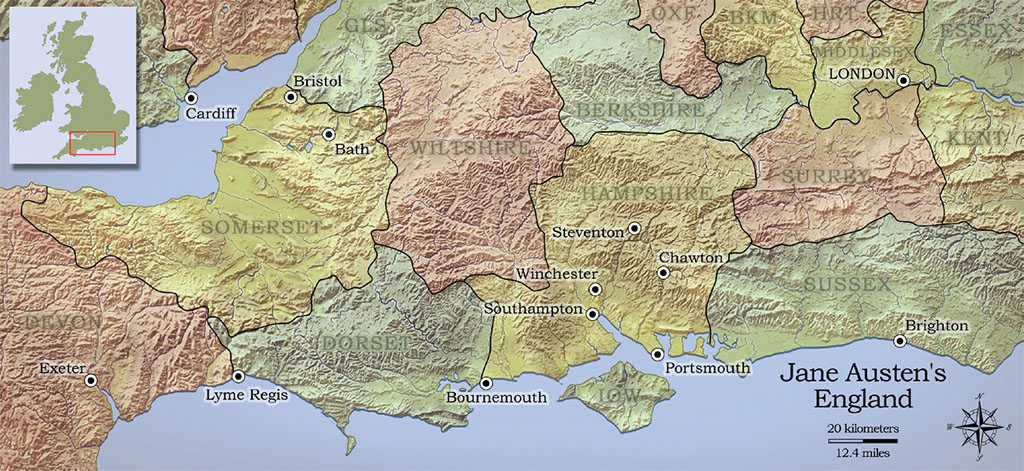
GREGORY PROCHE
Meanwhile, life in Chawton retains its own familiar pace as well. You can still see cattle grazing in the fields from Jane Austen’s House and along the cul-de-sac leading to Chawton Great House and St. Nicholas Church (where Jane’s mother and sister are buried in the churchyard). Jane Austen’s House is a museum of her life and art.
[caption id="JaneAustenatHome_img3" align="aligncenter" width="1024"]

DANA HUNTLEY
[caption id="JaneAustenatHome_img4" align="aligncenter" width="1023"]
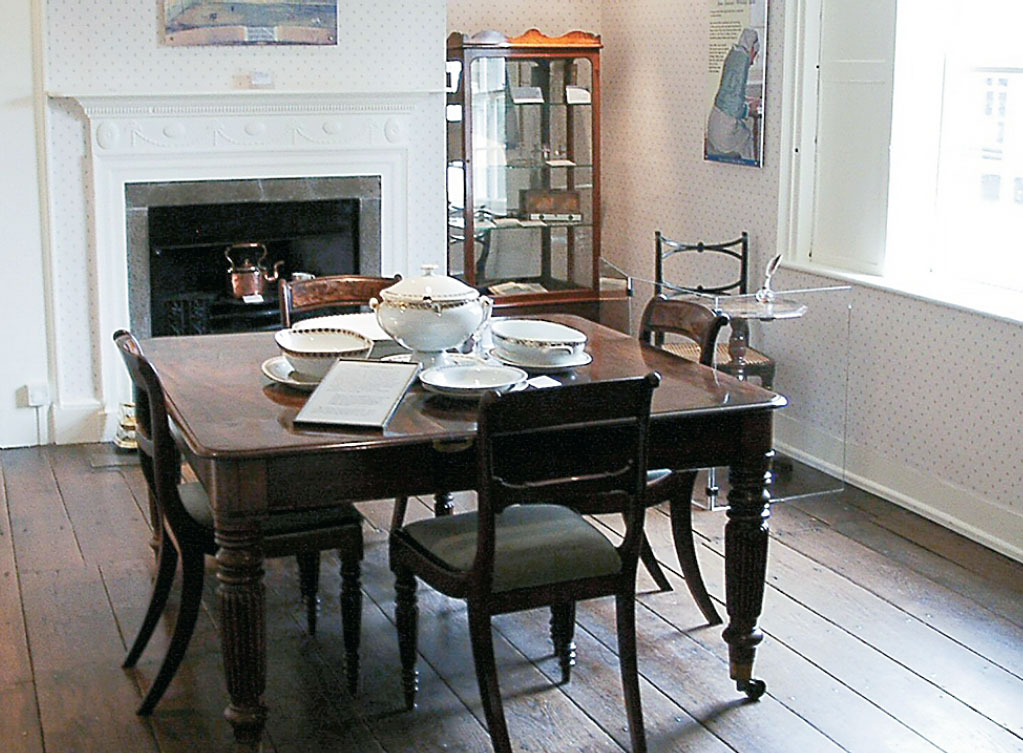
COURTESY OF JANE AUSTEN’S HOUSE MUSEUM
[caption id="JaneAustenatHome_img5" align="aligncenter" width="1024"]
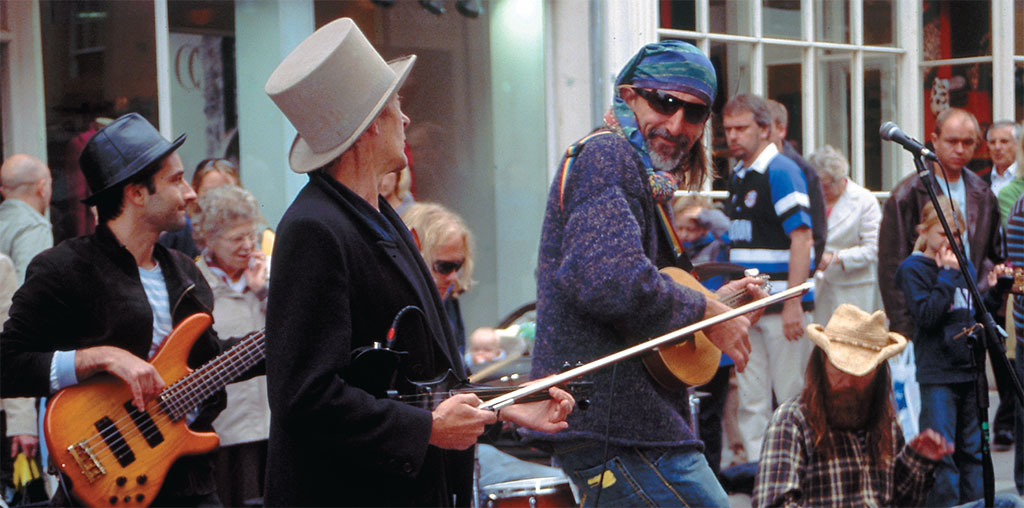
DANA HUNTLEY
Visiting the Jane Austen Sites
- St. Nicholas Church, Steventon: Up a narrow lane off the North Waltham—Steventon Road, the tiny 12th-century church is normally open every day. There are Austen memorials throughout. Think of the church as the place where Jane spent her Christmas Eves and Easters with her family as she grew up.
- Jane Austen Centre, 40 Gay Street, Bath: Between Queen Square and The Circus. Open throughout the year, 9:45 a.m. to 5:30 p.m.; winter hours mid-November to mid-March, 11 a.m. to 4:30 p.m. A permanent exhibition of Jane’s Bath experience, and center for all things Jane in the Georgian city. www.janeausten.co.uk
- Bath Tourism: What’s on? Where to stay? What to see? www.visitbath.co.uk
- Jane Austen’s House, Chawton, Hampshire: Off the A31 near Alton. Open March through December 10:30 a.m. to 4:30 p.m.; weekends only January and February. Admission is £6 In a major redevelopment, the Jane Austen House is building a visitors’ center beyond the bakehouse in the garden. Due for completion by July 2009—the 200th anniversary of the Austen arrival at Chawton—the project will take the gift shop, bookstore and offices out of the house and open the Austens’ kitchen to the public for the first time. www.jane-austenshouse-museum.org.uk
- Winchester Cathedral, Winchester: Winchester’s magnificent Gothic cathedral is open to visitors and pilgrims daily from 8:30 a.m. to 6 p.m. www.winchestercathedral.org.uk
[caption id="JaneAustenatHome_img6" align="aligncenter" width="513"]
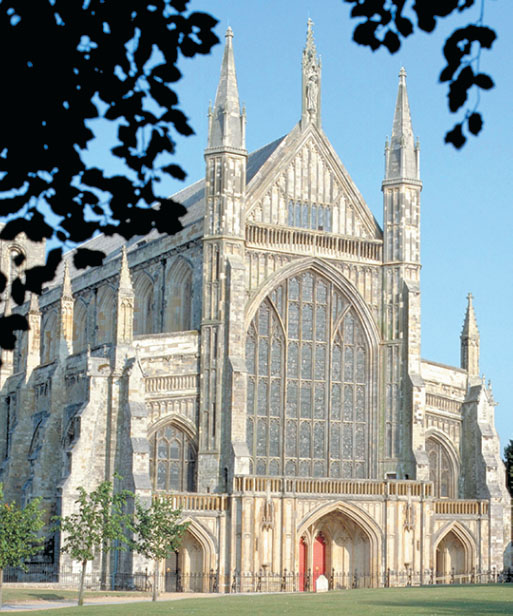
BRITAINONVIEW
Chawton, too, capitalizes on its most famous resident. The tearoom across the street is Cassandra’s Cup. And The Greyfriars, the cute village pub next door, couldn’t possibly serve such expensive pub lunches were it not for the brook of midday visitors who quietly stream to Chawton.
I visited at Jane Austen’s House with Tom Carpenter, curator and one of the museum’s trustees. He laughed easily about Bath’s claim. “I guess Bath has discovered that Jane Austen is more marketable than the Romans,” he concluded. Carpenter pointed out with recognizably English understatement that he thought Bath’s spokespeople may have slightly overstepped the mark.
“From what we know of Jane Austen’s time in Bath, from her correspondence and letters, Bath does not score well,” Carpenter said. “We go to Bath for the classic Georgian architecture; for Jane it was a new, modern city. I suspect she hated the social constraints—what you could or couldn’t say in open conversation—compared to what she knew in Hampshire. It would have been very irksome to her.”
True enough, we are not going to find folk strolling in Regency costume on the lanes of Chawton. But Jane Austen really wasn’t a city girl. As she herself averred, the ideal “stuff” of her novels was the social interaction between the several gentry families in an English village and its neighborhood.
Jane certainly knew the unhappiness the fashionable could bring, and ridiculed the pretensions that such a society fed. Bath did Catherine Moreland no good, and the older and wiser Anne Eliot was happy to leave the city behind.
Unquestionably, Jane Austen’s times and social milieu can be seen and imagined in Bath as nowhere else. The life she lived and about which she wrote with such deft strokes, however, still finds its true home in Chawton.





Comments